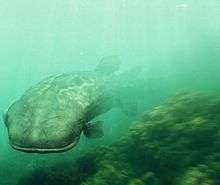Laccognathus
Laccognathus is an extinct genus of amphibious lobe-finned fish from Europe and North America. They existed from the Middle Devonian to the Late Devonian (around 397.5 to 360 mya). The name comes from Greek for 'pitted jaw'.[1]
| Laccognathus | |
|---|---|
 | |
| Reconstruction of Laccognathus panderi | |
| Scientific classification | |
| Kingdom: | Animalia |
| Phylum: | Chordata |
| Order: | †Porolepiformes |
| Family: | †Holoptychiidae |
| Genus: | †Laccognathus Gross, 1941 |
| Type species | |
| †Laccognathus panderi Gross, 1941 | |
| Species | |
|
See text. | |
Description
Species of Laccognathus were characterized by the presence of three large pits (fossae) on the external surface of the lower jaw which may have had sensory functions.[2] It is the origin of the genus name, from Greek λάκκος ('pit') and γνάθος ('jaw'). Laccognathus grew to approximately 1–2 metres (3.3–6.6 ft) in length. They had very short dorsoventrally flattened heads, less than one-fifth the length of the body. Like other sarcopterygians, their fins arise from pairs of fleshy lobes.[3]
The skeleton of Laccognathus was structured such that large areas of the skin were stretched out over solid plates of bone. This bone was composed of particularly dense fibers—so dense that cutaneous respiration (exchange of oxygen through the skin) was not a likely trait exhibited by Laccognathus. Rather, the dense ossifications may have served to retain water inside the body as Laccognathus traveled on land between bodies of water.[4]
Taxonomy
Laccognathus are classified under the family Holoptychiidae in the extinct order Porolepiformes.[5] They are not direct ancestors of tetrapods like the clade Tetrapodomorpha, but instead belong to the clade Dipnomorpha. Their closest living descendants are the members of the subclass Dipnoi (lungfishes).[6][7]
Species
The following are the species classified under Laccognathus. A fourth undescribed species recovered from the Middle Devonian of Latvia may exist.[3]
- †Laccognathus panderi Gross, 1941
- Recovered from the Middle Devonian and Late Devonian formations of various parts of eastern Europe.[3][8]
- †Laccognathus grossi Vorobyeva, 2006
- Recovered from the Middle Devonian Gauja Formation of Latvia.
- †Laccognathus embryi Downs et al., 2011
- Recovered from Late Devonian Fram Formation of Ellesmere Island, Canada, the same locality from which Tiktaalik was found.[1]
See also
| Wikimedia Commons has media related to Laccognathus. |
- Holoptychius
- Sarcopterygii
- List of sarcopterygians
- List of prehistoric bony fish
References
- Dell'Amore, C. (September 12, 2011). "Ancient Toothy Fish Found in Arctic—Giant Prowled Rivers". National Geographic Daily News. Retrieved September 13, 2011.
- Tom Avril (September 12, 2011). "Fish fossil sheds light on 'Euramerica' phase". The Inquirer. Retrieved September 15, 2011.
- Vorobyeva, E.I. (2006). "A new species of Laccognathus (Porolepiform Crossopterygii) from the Devonian of Latvia". Palaeont. J. Physorg.com. 40 (3): 312–322. doi:10.1134/S0031030106030129.
- Downs, J., Daeschler, E., Jenkins, F. Jr., & Shubin, N. (2011). "A New Species of Laccognathus (Sarcopterygii, Porolepiformes) from the Late Devonian of Ellesmere Island, Nunavut, Canada". Journal of Vertebrate Paleontology. 31 (5): 981–996. doi:10.1080/02724634.2011.599462.CS1 maint: multiple names: authors list (link)
- Witzmann, F. (2009). "Comparative histology of sculptured dermal bones in basal tetrapods, and the implications for the soft tissue dermis" (PDF). Palaeodiversity. 2: 233–270.
- Dennis C. Murphy. "More About Lobe-Fins: Sarcopterygii". Devonian Times. Retrieved September 15, 2011.
- Stiassny, M., Parenti, L., & Johnson, G.D. (1996). Interrelationships of Fishes. Academic Press. p. 466. ISBN 978-0-08-053492-3.CS1 maint: multiple names: authors list (link)
- Moloshnikov, S.V. (2007). "Psammosteiforms (Agnatha, Heterostraci) from the Lower Frasnian of the Mikhailovskii Mine, Kursk Region, Russia". Paleontol. J. 41 (5): 84–88. doi:10.1134/s0031030107050115.